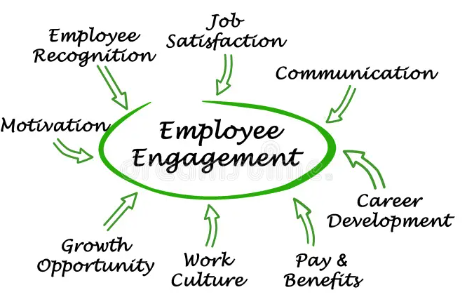Worldwide Employee Engagement: Strategies To Improve The Global Crisis

Employee engagement and an overview of worldwide employee engagement
Employee engagement refers to the involvement and enthusiasm of employees in their workplace and work. In today’s competitive marketplace, employee engagement has surfaced as a critical driver of business success. Increased levels of engagement encourage talent retention, stimulate customer loyalty, and enhance organizational performance along with stakeholder value.
However, it is seen that the worldwide employee engagement levels have continued to remain static over the years. It is not enough to measure the engagement alone to ascertain its improvement. Certain strategies can help improve worldwide employee engagement.
The employee engagement crisis has engulfed the world, presenting serious and probably long-lasting ramifications for the worldwide economy. Though organizations recognize employee engagement’s significance, there has been little progress in enhancing it for over a decade.
Since 2000, Gallup has been looking over employee engagement in the US. As per their study, less than one-third of US employees have been enthusiastically involved in their work and workplaces throughout the last 15 years. The daily tracking data of Gallup states that only 32% of employees in the US demonstrate engagement and showcase their enthusiasm, involvement, and dedication to their work and organization. At a worldwide scale, only 13% of employees working in organizations are engaged.
Computing engagement with surveys is vital; however, it is not enough to drive the required improvement. To overcome worldwide employee engagement, organizations must adopt strategies that have successfully improved employee engagement. Organizations can form a more engaged workforce by implementing the strategies, expediting enhanced productivity, employee satisfaction, and comprehensive organizational success.
Unleashing sustainable employee engagement
Though organizations are paying attention to employee engagement, worldwide employee engagement remains stagnant. In this situation, organizations must discover the answer to a key question, ‘Why are engagement levels not increasing?’ In searching for the answer, organizations will come across many factors that add to this challenging situation and can also reflect on their data concerning the initiatives for employee engagement. A division is becoming visible in the engagement industry, with validated approaches on one side and invalidated approaches like unfocused surveys on the other.
Validated approaches concentrate on individual and business performance, using strategic development remedies to change organizational cultures. Though the approaches need investment and intentionality, they enhance worldwide employee engagement.
In contrast, invalidated approaches depend only on annual surveys, which fail to align with the organizational objectives and usually fail to steer meaningful action. Only computing engagement without actively enhancing it will give rise to missed opportunities.
Looking at engagement as an initiative instead of a progress-disciplined approach and classifying surveys over manager and employee development delays progress. Defining engagement as simple contentment or satisfaction ignores the significance of involvement, enthusiasm, and commitment.
Concentrating on charming employees instead of permitting them as stakeholders hinders true engagement. Worldwide employee engagement is further hindered by making decisions according to cost and deliverables instead of long-term workplace improvement.
The flaws in the approaches engulf the organizations in a cycle of regular engagement efforts, bringing about untrue promises and less follow-up. To encourage sustainable worldwide employee engagement, organizations must shift their focus from metrics-based solutions to all-inclusive strategies that steer lasting change and put employee empowerment first.
Strategies to develop high-engagement

Inferring from in-depth research and coordination with top-performing organizations, Gallup has pointed out five crucial strategies to improve worldwide employee engagement and steer performance.
Combine engagement into an organization’s human capital strategy: Successful organizations prioritize engagement by entailing leaders, adopting effective communication strategies, setting up accountability systems, and organizing learning and development programs with engagement goals. Instead of a periodic effort, engagement becomes a continuous process coordinated into daily business operations.
Comprehend the beginning point and form realistic goals: Every organization has distinctive abilities and preparedness for change. It is vital to evaluate the present state of worldwide employee engagement and create an achievable roadmap basis the particular needs of the organizations. The approach sets realistic milestones and leads actions that align with the desired future state.
Use scientifically validated measurement tools: Several employee surveys are designated ‘engagement’ surveys; however, only some have undergone rigorous peer review or validation. To genuinely enhance engagement, companies require trustworthy instruments that correctly compute the factors affecting engagement, permitting concentrated action on the correct areas.
Stress tactical components that steer performance: Engagement is not an unaided concept but the result of complete performance management exercises. Concentrating on clarifying work expectations, giving essential resources, instilling positive relationships, and playing with individual strengths improves worldwide employee engagement and complete performance.
Align engagement with other organizational tasks: Integrating engagement into daily work is essential instead of considering it as an additional task. Giving time in engagement means integrating its principles into daily workflows, adjusting to new initiatives, and confirming employees have the essential support and opportunities to shine. Leaders play a significant role in rebooting expectations, giving resources, and building a culture where engagement flourishes.
Developing a culture of worldwide employee engagement goes above conducting annual surveys. It needs a complete examination of the critical components that steer engagement coordinated with performance and the organization’s human capital strategy. Leaders and managers can develop a thriving work environment that drives success by prioritizing engagement and identifying its effect on employee and organizational outcomes.
Role of managers in enhancing employee engagement
The Gallup report shows managers impact up to 70% of employee engagement levels. It is seen that effective communication is connected to increased engagement. Managers have a big role in developing employees according to their strengths. We have already discussed Gallup’s report, which states that the decreasing worldwide employee engagement affects economic growth and innovations and poses a significant threat to future prospects.
Gallup’s report, ‘State of the American Manager: Analytics and Advice for Leaders,’ examines the attributes of great managers and investigates the critical link between engagement, talent, and main business outcomes, like productivity and profitability. Surprisingly, managers are the reason for at least 70% of the difference in employee engagement scores. Most managers fail to build environments that encourage and motivate employees. The Gallup study disclosed that half of the US adults have resigned from their work to evade their manager’s negative impact at some time in their careers.
Working under a bad manager impacts employees’ working hours and reaches out to their personal lives, increasing stress and well-being. But simply tagging managers as good or bad is not enough. Organizations must comprehend the behaviors managers demonstrate that either develop or thwart engagement.
The study conducted by Gallup on 7712 adults in the US pointed out the critical effect of performance management, communication, and strengths-based development on worldwide employee engagement. By concentrating on these aspects, organizations can get valuable insights to transform their managers and increase overall business performance.
Role of Communication in developing strong relationship at the workplace
It is found that constant communication is connected to enhanced employee engagement. Daily meetings and regular communication positively influence engagement. Managers who exhibit genuine care and devote time to their employees instill increased engagement.
Communication is a foundation for all healthy relationships, and the employee-manager relationship is no different. The research by Gallup discloses that constant and trustworthy communication, either in person or through electronic mediums, is strongly related to higher levels of engagement. For example, employees whose managers conduct daily meetings are probably three times more engaged than those who do not communicate with their managers daily.
It is said that worldwide employee engagement reaches its highest when employees have some sort of regular daily communication, whether in person or through digital mediums, with their managers. Managers who use a stable mix of communication mediums are more successful in engaging their employees. Engaged employees also report that their managers instantly respond to their messages and calls within 24 hours. The continuous communication makes the employees realize that their managers know their present tasks and projects.
However, simple transactional communication between employees and managers is insufficient to increase engagement. Employees admire managers who not only communicate with them concerning their work but also about their personal lives. Gallup’s study points out that employees who think that their managers invest themselves in knowing about their well-being are probably more engaged.
Exceptional managers constantly try to understand their employees and create an environment where open communication is welcomed. They prefer developing honest relationships, ensuring employees feel comfortable while explaining a broad range of topics, including personal and professional. A constructive workplace instills a sense of safety, helping team members take risks, share information, challenge ideas, and support one another. Employees are ready to believe their organization and managers in such an atmosphere. But nothing of such kind is possible if employees do not feel cared for.
Great managers have the skill to attain employee motivation and job satisfaction and establish genuine connections with them. They identify and clasp the distinctiveness of each individual they handle, recognize their diverse victories, and challenge both on and off the work. Managers successfully steer high performance and worldwide employee engagement by prioritizing employees’ well-being and instilling a supportive environment.
Redefining performance management by empowering performance
Performance management sometimes makes employees feel disconnected and uncertain. But when done accurately, it drives productivity and engagement. The key to successful performance management is clarity of expectations and continuous conversations.
Employees often feel frustrated due to traditional performance management techniques as they try to understand their goals and the expectations put down upon them. Several employees feel disconnected from the larger picture and find developmental communications and annual reviews superficial and forced. It turns out to be challenging for them to imagine long-term goals when they fall short of clarity concerning their everyday tasks.
But when performance management is implemented well, it can change employees into innovative, productive, and valuable contributors. The research from Gallup discloses that employees whose managers shine at performance management exercises are more engaged than those whose managers combat these responsibilities.
The Q12 research by Gallup revealed the significance of clarity of expectations as one of the basic needs of employees. Assisting employees in comprehending their roles is not limited to describing the job responsibilities. Exceptional managers communicate continuously with employees concerning their duties and progress instead of doing this discussion in a year during the performance appraisal period.
Engaged employees often indicate that their managers help them rank their work priorities and performance goals. The employees also recognize being held responsible for their performance. Engaged employees consider accountability as being treated equally by their managers and support constant standards, permitting better performers to excel.
Appropriate performance management is more than frequent analysis; it needs continuous dialogue and support. By instilling a culture of consistent feedback and open conversations, managers can permit their employees to attain their entire potential, developing productivity, engagement, and growth.
Developing a culture of success by taking advantage of strengths
It is found that concentrating on employee’s strengths leads to better results than correcting their weaknesses. A strengths-based culture induces increased productivity, retention, and worldwide employee engagement. Managers who build the strength of the employees steer team engagement.
After many decades of analyzing human behavior and strengths, Gallup concluded that stressing and developing employee strengths is more effective than brooding over weaknesses. In a strengths-based culture, employees undergo fast learning, bring about higher-quality work, demonstrate greater durability within their organization, and exhibit higher levels of engagement.
The research found that nearly 67% of the employees agree that their managers concentrate on their strengths, whereas 31% believe that their managers stress correcting their weaknesses.
When managers prefer growth and development of the employee’s strengths, they highly enhance their capability to engage team members. The most influential addition a manager can make is placing employees in roles that weigh on their inbuilt talents and permit them to employ and enhance their strengths with skill and knowledge.
By implementing a strengths-based method, organizations can instill an environment where employees develop, unleash their complete potential, and drive toward success. Managers who comprehend and encourage their employee’s strengths lead to worldwide employee engagement that drives productivity, innovation, and collaboration.
Total Assignment Help
In case, you are looking for an opportunity to work from home and earn big money. TotalAssignmenthelp Affiliate program is the best choice for you.
Do Visit: https://www.totalassignment.com/affiliate-program for more details
Total Assignment Help is an assignment help Online service available in 9 countries. Our local operations span Australia, the US, the UK, Southeast Asia, and the Middle East. With extensive experience in academic writing, Total Assignment Help has a strong track record of delivering quality writing at a nominal price that meets the unique needs of students in our local markets. We have a specialized network of highly trained writers, who can provide the best possible assignment help solution for all your needs. Next time you are looking for assignment help, make sure to give us a try.


